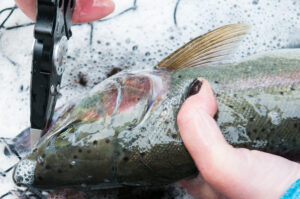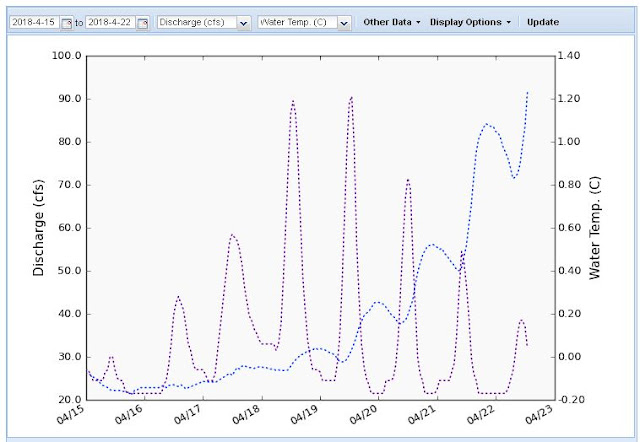
What is the Minnesota Steelheader Creel Project?
The heart of the Minnesota Steelheader Creel Project is a long-term warehouse of angler catch information incorporating real-time environmental conditions recorded in North Shore streams during annual spring and fall migrations. It is designed to collect data similar to that of official Minnesota DNR creel reports, and uses the same creel beats to assure reporting parity. The MNST-CP is solely funded by Minnesota Steelheader, relying entirely on volunteer angler submissions to help gather data in furtherance of North Shore steelhead understanding.
While the MNST-CP is non-scientific in that we don’t employ the same collection methodologies and controls as the DNR creel, it does utilize as much of the currently available scientific literature as is possible. The primary difference is that this is done from an angler’s perspective. The resulting tools provide an opportunity to be a more knowledgeable and most importantly, a more successful North Shore steelheader.
The North Shore Region, sample date, stream-flow, water temperature, species and number caught are all analyzed and charted in context at the conclusion of each year’s run. This provides all of us with a detailed picture of steelhead fishing on the North Shore. MNST publishes the information for you to think about and use whether you are brand new to the sport, or a veteran of 40 seasons.




How it Works: Volunteer anglers access MNST’s secure (HTTPS) Creel Project submission form via web browser to submit basic information on clipped and un-clipped steelhead, as well as presumed coaster brook trout and other fall-run species caught while fishing. MNST does not ask for river names, we only collect the North Shore Region: Lower, Middle or Upper. After the end of the run, typically in July, we compile all submitted creel data into Daily, Weekly and long-term Historical charts that illustrate how run timing and catch was and is influenced by environmental variables within each region of the North Shore. Finally, MNST uses open-source fisheries data to compile annual reports to illustrate how the science is applicable to fishing.
While the primary focus is on steelhead caught in the tributaries during the Spring migration and spawning run, we gratefully accept and appreciate creel reports year-round for all migratory fish.
For those not familiar with the MNST Creel Project
We use a number of acronyms and terms throughout MNST Creel Project Reports; the following are some of the most useful to know up front:
- CGP – Coaster Genetics Project. A citizen-science partnership with Minnesota DNR Fisheries that utilizes trained volunteer anglers to obtain genetic material through the application of low-impact fin clips. This genetic sampling program studies Coaster Brook Trout populations and genetics along the North Shore of Minnesota. Links to the program page are embedded throughout where CGP is used
- Creel Region – The geographic region of the North Shore where each stream is located. Reported data is defined by the following creel reporting beats:
- Lower Shore – All streams from Mission Creek to Knife River
- Mid Shore – All streams from Stewart River to Baptism River
- Upper Shore – All streams from Little Marais River to Pigeon River
- SGP – Steelhead Genetics Project. A citizen-science partnership with Minnesota DNR Fisheries that utilizes trained volunteer anglers to obtain genetic material through the collection of scale samples. This genetic sampling program studies Steelhead populations and genetics along the North Shore of Minnesota. Links to the program page are embedded throughout where SGP is used
- MMT – Major Migration Threshold. If you have never read one of the MNST annual creel project reports, or if you just want a refresher regarding MMT, we encourage you to skip down to the Information Regarding Stream Temperatures and the “Major Migration Threshold” section of the 2019 report and read that first. It explains in great detail why MNST focuses on the major migration threshold, and why North Shore steelhead migrations appear to be somewhat unique in this respect
Additional Note: MNST strives to present the most comprehensive information possible, and as a result the reports are heavy with graphics and explanations that tie in the scientific literature regarding North Shore steelhead. Since we are trying to provide you with the best information available, it means MNST Creel Project Reports are not a 3-minute read. Most reports are ~20 pages without the graphics, so grab your favorite beverage and take your time reviewing them. They are also best viewed from a desktop or laptop computer. You can do it in mobile, but it can be frustrating sizing all of the charts.

About the Creel Project and how we prepare data
The Creel Project looks to answer basic questions we receive year after year from anglers:
- When do the fish run?
- Where do they run?
- How long do runs last?
- When is the best time to go?
- How or when should I plan a trip? I travel long distances and only get one or two opportunities to get out and fish each year.
We also have a list of more complex questions we want to explore:
- Why do North Shore steelhead appear to be unique in certain respects compared to steelhead from the other Great Lakes?
- Is there a typical run timing and what does that look like for each region?
- Are there distinct differences in run timing and duration between the various regions of the North Shore?
- How do flow and temperature specifically affect North Shore steelhead returns during various stages of migration?
- What other factors or data can we use to corroborate run timing?
- How might the kamloops replacement program change Lower Shore run dynamics and overall fishing throughout the year?

Each year we come up with more questions to explore, or some new twist that challenges us to re-think. Based on defined goals, we package up all creel submissions and present the data in a variety of different ways, the basics of which are as follows:
- Daily Reporting: Daily creel trend is plotted to help you visualize the more granular interactions between steelhead and the primary environmental factors of flow and temperature
- Weekly Reporting: All daily creel reports are plotted in a weekly format. This removes a lot of the day-to-day noise, and helps you to visualize the overall progression of the run
- Historical Reporting: The daily and weekly data from each individual region are nested within all prior-year’s data to create a unified historical picture. This is done for each individual Region: Lower, Mid and Upper Shore, as well as at the Shore-Wide level. These historical charts provide the context for looking ahead. They are not a prediction by any means, but they do provide the framework in which to understand the basics of North Shore steelhead migration: When do the steelhead typically start, how do runs typically progress along the Shore, when do they typically peak, and when do they typically end
What can you do to help?
Please consider submitting a report as you fish this season. We cannot do this without you, and there are a minimum number of annual fish samples required from each region to make this project work. MNST staff can fish with the best of them, but we are not good enough to provide sufficient samples for the entire project. The Creel Project form is quick and easy to complete: Check some boxes, Click Submit, it is that simple.
Some anglers express concerns that the information we collect will be distributed in a time and manner which will bring more pressure to the rivers they fish. We understand, which is why MNST only collects and shares generalized regional data. Never information by stream name, and never during the current run. We do not share information at any time or in any way that would put artificial pressure on any river or any region during your fishing season. Never have, never will, 23 years and counting…
If you are still hesitant but think you may want to contribute, we welcome you to hold your creel submissions until the run is concluded. All we ask is that we receive your reports by June 30th, and that the catch dates and numbers are accurate. Feel free to review the collection form by clicking the link below. No submission required, just close it out when finished looking it over.

Past Creel Results & Misc. Data
Click the PDF links below to view/save documents
- 2021 Creel Project Report
- 2020 Creel Project Report
- 2019 Creel Project Report
- 2018 Creel Project Report
- Pre-2018 MNST Creel Reports are still being transferred from our old system. We apologize for the delays
